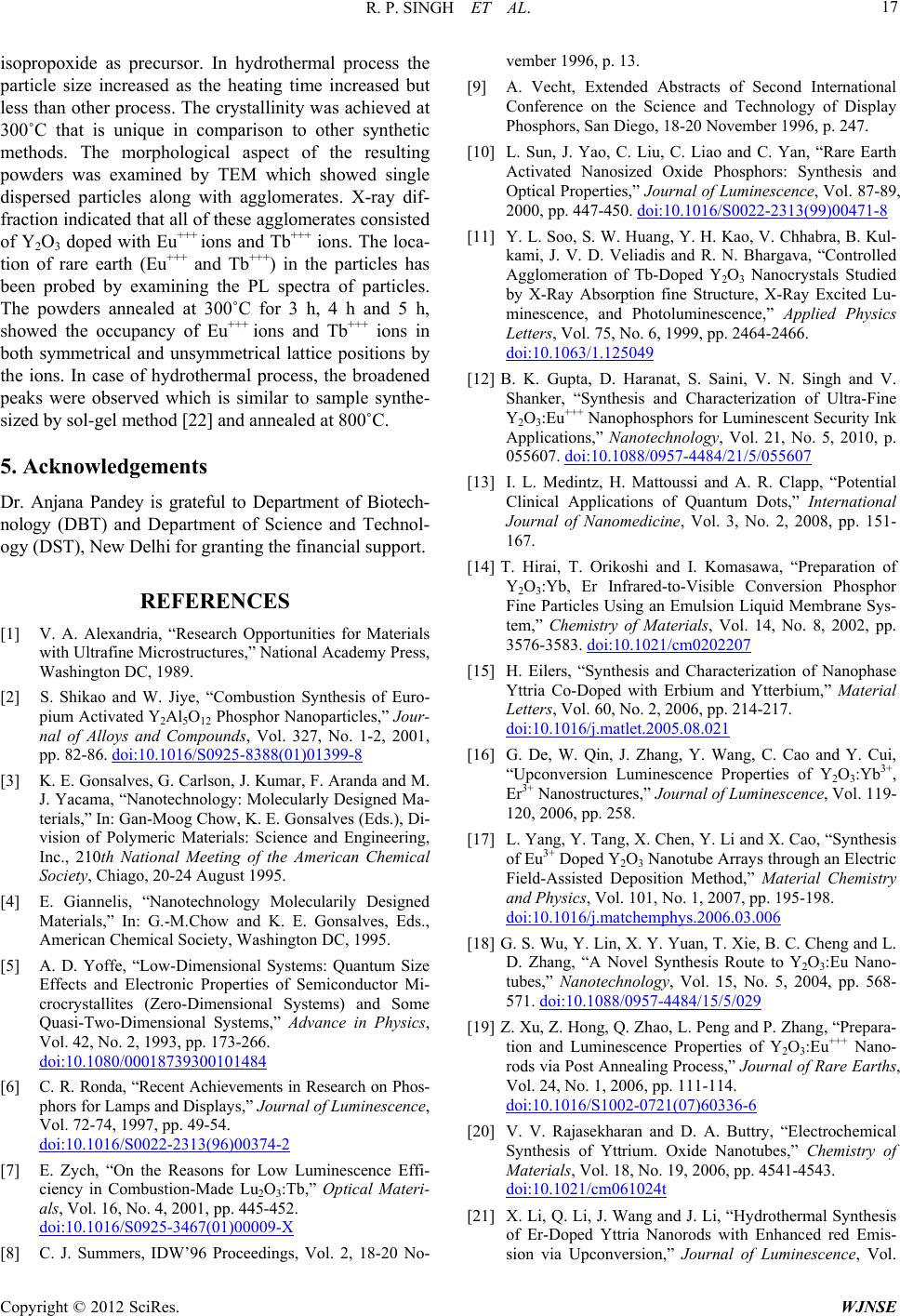
R. P. SINGH ET AL. 17
isopropoxide as precursor. In hydrothermal process the
particle size increased as the heating time increased but
less than other process. The crystallinity w as achieved at
300˚C that is unique in comparison to other synthetic
methods. The morphological aspect of the resulting
powders was examined by TEM which showed single
dispersed particles along with agglomerates. X-ray dif-
fraction indicated that all of these agglomerates consisted
of Y2O3 doped with Eu+++ ions and Tb+++ ions. The loca-
tion of rare earth (Eu+++ and Tb+++) in the particles has
been probed by examining the PL spectra of particles.
The powders annealed at 300˚C for 3 h, 4 h and 5 h,
showed the occupancy of Eu+++ ions and Tb+++ ions in
both symmetrical and unsymmetrical lattice positions by
the ions. In case of hydrothermal process, the broadened
peaks were observed which is similar to sample synthe-
sized by sol-gel method [22] and annealed at 800˚C.
5. Acknowledgements
Dr. Anjana Pandey is grateful to Department of Biotech-
nology (DBT) and Department of Science and Technol-
ogy (DST), New Delhi for granting the financial support.
REFERENCES
[1] V. A. Alexandria, “Research Opportunities for Materials
with Ultrafine Microstructures,” National Academy Press,
Washington DC, 1989.
[2] S. Shikao and W. Jiye, “Combustion Synthesis of Euro-
pium Activated Y2Al5O12 Phosphor Nanoparticles,” Jour-
nal of Alloys and Compounds, Vol. 327, No. 1-2, 2001,
pp. 82-86. doi:10.1016/S0925-8388(01)01399-8
[3] K. E. Gonsalves, G. Carlson, J. Kumar, F. Aranda and M.
J. Yacama, “Nanotechnology: Molecularly Designed Ma-
terials,” In: Gan-Moog Chow, K. E. Gonsalves (Eds.), Di-
vision of Polymeric Materials: Science and Engineering,
Inc., 210th National Meeting of the American Chemical
Society, Chiago, 20-24 August 1995.
[4] E. Giannelis, “Nanotechnology Molecularily Designed
Materials,” In: G.-M.Chow and K. E. Gonsalves, Eds.,
American Chemical Society, Washington DC, 1995.
[5] A. D. Yoffe, “Low-Dimensional Systems: Quantum Size
Effects and Electronic Properties of Semiconductor Mi-
crocrystallites (Zero-Dimensional Systems) and Some
Quasi-Two-Dimensional Systems,” Advance in Physics,
Vol. 42, No. 2, 1993, pp. 173-266.
doi:10.1080/00018739300101484
[6] C. R. Ronda, “Recent Achievements in Research on Phos-
phors for Lamps and Displays,” Journal of Luminescence,
Vol. 72-74, 1997, pp. 49-54.
doi:10.1016/S0022-2313(96)00374-2
[7] E. Zych, “On the Reasons for Low Luminescence Effi-
ciency in Combustion-Made Lu2O3:Tb,” Optical Materi-
als, Vol. 16, No. 4, 2001, pp. 445-452.
doi:10.1016/S0925-3467(01)00009-X
[8] C. J. Summers, IDW’96 Proceedings, Vol. 2, 18-20 No-
vember 1996, p. 13.
[9] A. Vecht, Extended Abstracts of Second International
Conference on the Science and Technology of Display
Phosphors, San Diego, 18-20 November 1996, p. 247.
[10] L. Sun, J. Yao, C. Liu, C. Liao and C. Yan, “Rare Earth
Activated Nanosized Oxide Phosphors: Synthesis and
Optical Properties,” Journal of Luminescence, Vol. 87-89,
2000, pp. 447-450. doi:10.1016/S0022-2313(99)00471-8
[11] Y. L. Soo, S. W. Huang, Y. H. Kao, V. Chhabra, B. Kul-
kami, J. V. D. Veliadis and R. N. Bhargava, “Controlled
Agglomeration of Tb-Doped Y2O3 Nanocrystals Studied
by X-Ray Absorption fine Structure, X-Ray Excited Lu-
minescence, and Photoluminescence,” Applied Physics
Letters, Vol. 75, No. 6, 1999, pp. 2464-2466.
doi:10.1063/1.125049
[12] B. K. Gupta, D. Haranat, S. Saini, V. N. Singh and V.
Shanker, “Synthesis and Characterization of Ultra-Fine
Y2O3:Eu+++ Nanophosphors for Luminescent Security Ink
Applications,” Nanotechnology, Vol. 21, No. 5, 2010, p.
055607. doi:10.1088/0957-4484/21/5/055607
[13] I. L. Medintz, H. Mattoussi and A. R. Clapp, “Potential
Clinical Applications of Quantum Dots,” International
Journal of Nanomedicine, Vol. 3, No. 2, 2008, pp. 151-
167.
[14] T. Hirai, T. Orikoshi and I. Komasawa, “Preparation of
Y2O3:Yb, Er Infrared-to-Visible Conversion Phosphor
Fine Particles Using an Emulsion Liquid Membrane Sys-
tem,” Chemistry of Materials, Vol. 14, No. 8, 2002, pp.
3576-3583. doi:10.1021/cm0202207
[15] H. Eilers, “Synthesis and Characterization of Nanophase
Yttria Co-Doped with Erbium and Ytterbium,” Material
Letters, Vol. 60, No. 2, 2006, pp. 214-217.
doi:10.1016/j.matlet.2005.08.021
[16] G. De, W. Qin, J. Zhang, Y. Wang, C. Cao and Y. Cui,
“Upconversion Luminescence Properties of Y2O3:Yb3+,
Er3+ Nanostructures,” Journal of Luminescence, Vol. 119-
120, 2006, pp. 258.
[17] L. Yang, Y. Tang, X. Chen, Y. Li and X. Cao, “Synthesis
of Eu3+ Doped Y2O3 Nanotube Arrays through an Electric
Field-Assisted Deposition Method,” Material Chemistry
and Physics, Vol. 101, No. 1, 2007, pp. 195-198.
doi:10.1016/j.matchemphys.2006.03.006
[18] G. S. Wu, Y. Lin, X. Y. Yuan, T. Xie, B. C. Cheng and L.
D. Zhang, “A Novel Synthesis Route to Y2O3:Eu Nano-
tubes,” Nanotechnology, Vol. 15, No. 5, 2004, pp. 568-
571. doi:10.1088/0957-4484/15/5/029
[19] Z. Xu, Z. Hong, Q. Zhao, L. Peng and P. Zhang, “Prepara-
tion and Luminescence Properties of Y2O3:Eu+++ Nano-
rods via Post Annealing Process,” Journal of Rare Earths,
Vol. 24, No. 1, 2006, pp. 111-114.
doi:10.1016/S1002-0721(07)60336-6
[20] V. V. Rajasekharan and D. A. Buttry, “Electrochemical
Synthesis of Yttrium. Oxide Nanotubes,” Chemistry of
Materials, Vol. 18, No. 19, 2006, pp. 4541-4543.
doi:10.1021/cm061024t
[21] X. Li, Q. Li, J. Wang and J. Li, “Hydrothermal Synthesis
of Er-Doped Yttria Nanorods with Enhanced red Emis-
sion via Upconversion,” Journal of Luminescence, Vol.
Copyright © 2012 SciRes. WJNSE